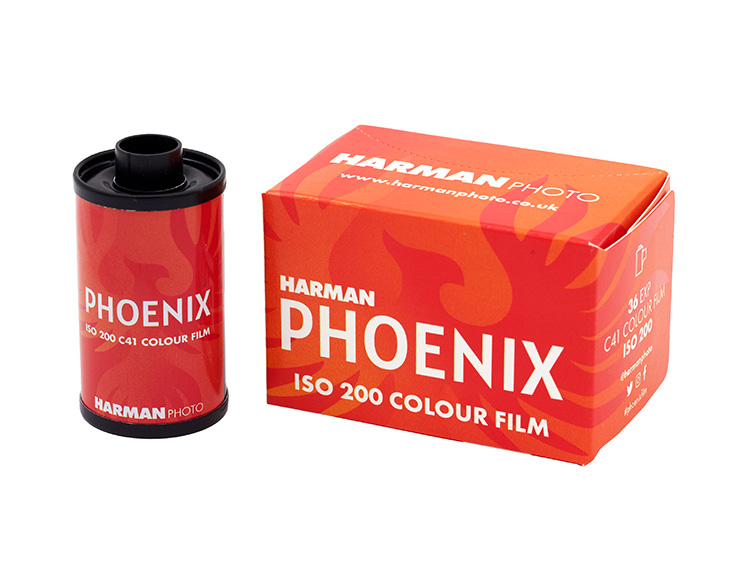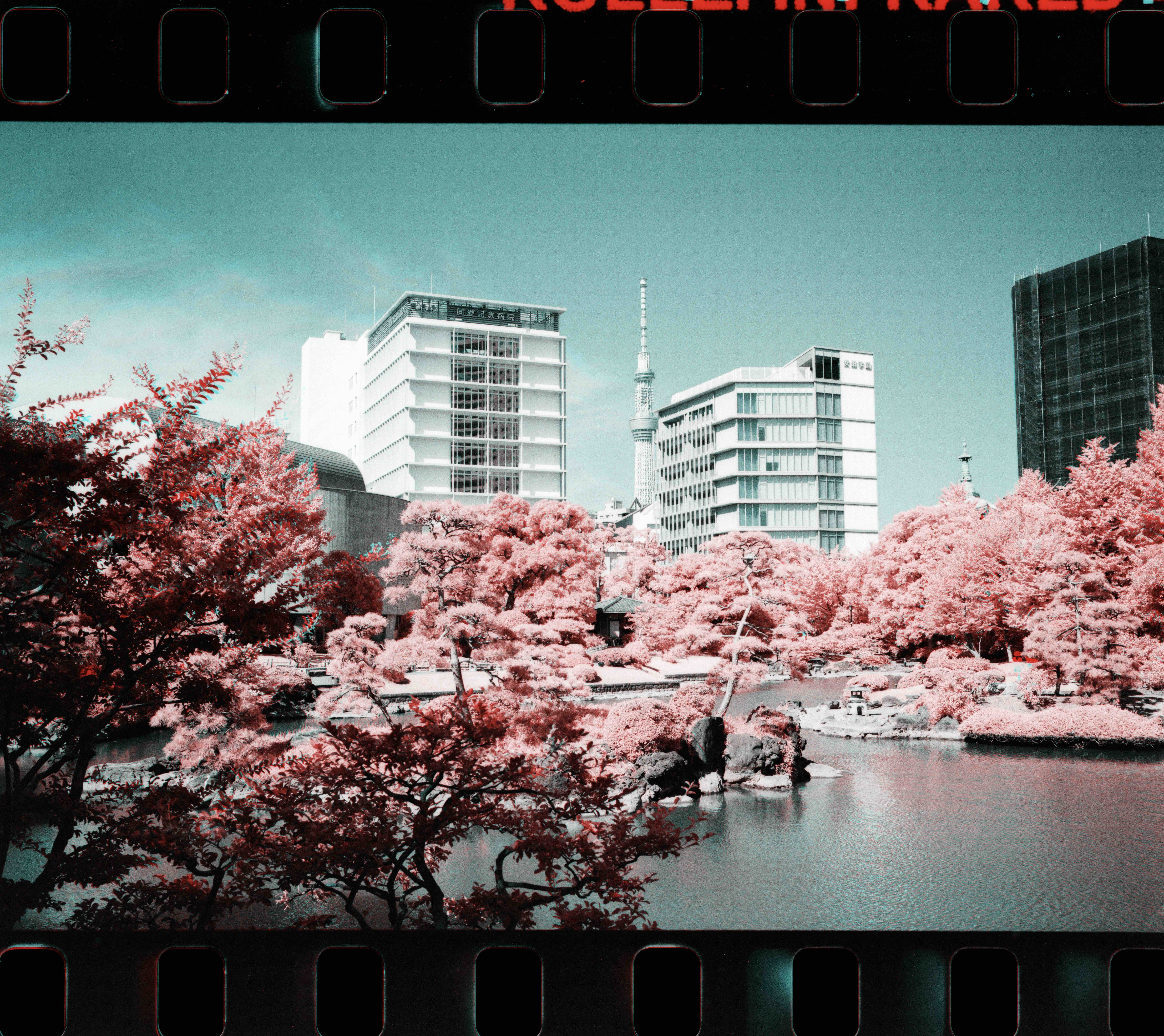はじめに
近年、フィルム写真が再び注目を集めています。そんな中で話題のカラーネガフィルム「Harman Phoenix200」について、あるレビューでは「ダイナミックレンジが狭い」との指摘がありました。しかし、実際に使用してみると、明るい部分から暗部までしっかりとディテールを捉えてくれるフィルムであることが分かります。本記事では、1枚の作例写真を交えながら、Harman Phoenix200の広いダイナミックレンジについて解説します。
本記事のポイント
- Harman Phoenix200のダイナミックレンジが狭いというadaminsightsのレビューへの反論
- 作例写真で証明する広いダイナミックレンジ
Harman Phoenix200の特徴
- 発色の豊かさ
Harman Phoenix200は、鮮やかな色再現が特徴です。特に空の青色や植物の緑色は、デジタルでは再現しにくい深みを感じさせます。 - 立体感と粒状感
フィルムならではの粒状感が、被写体を立体的に表現します。光と影のコントラストが自然で、余韻のある写りが楽しめます。 - 広いダイナミックレンジ
adaminsightsでは「狭い」と評されることもあるPhoenix200ですが、適切な撮影条件や現像処理を行うことで、暗部からハイライトまでしっかりとディテールを残すことが可能です。
The Harman Phoenix is a colour negative film with an ISO rating of 200, intended for use with the standard C-41 development process. Ideally, you’d use it outside on a nice sunny day or with a flash if you took it indoors. At its introduction, it’s only offered in 35mm format, though there’s talk of Harman possibly releasing it in 120mm as well.
The film is characterised by its high contrast, intense saturation, and pronounced grain that seems excessive for its ISO 200 speed. To me, it feels like the visual equivalent of an over-edited photo where the effects have been applied with a heavy hand – too much contrast, saturation dialed up to an extreme, and grain that wouldn’t be out of place in an ISO 1600 film. The resulting images are so heavily processed that they leave little room for any further editing.
Too much noise, saturation and contrast. And there is little in dynamic range to be able to recover any of it. All my samples were from high res TIFF scans.
There is a total lack of detail in the shadows as shown in these samples.
Again, trying to recover the detail in these shadows is impossible. Unlike for example Kodak Portra which is much more versatile and forgiving with plenty of detail in the shadows.
参考URL:https://www.adaminsights.com/harman-phoenix-colour-film-review-i-dont-like-it/
本編
以下の3枚の写真は、全部同一の写真ですが、RawTherapeeで露光量およびダイナミックレンジ圧縮を調整した結果で、仕上がりが大きく変化しています。Harman Phoenix200のダイナミックレンジを考えるうえで、とても興味深い比較例といえるでしょう。
1枚目:アンダー露出

最初の写真は露光不足のため、全体的に暗く沈んでいます。ビルや木々などの被写体はシルエットに近い状態で、画面下部の池や木々の細部がつぶれてしまいがちです。しかし、空部分には白飛びせず雲の模様が残り、ハイライト側に余裕がある印象も受けます。
ポイント
- 暗部がかなりつぶれている
- ハイライトは白飛びを抑えられている
- 空の色合いはある程度残っている
2枚目:オーバー露出

2枚目は逆に露光オーバーです。空が真っ白く飛んでしまい、雲の階調が失われています。一方、ビルや木々のディテールは最初の写真よりも多少見えやすくなりました。オーバー目に撮影すると、暗部の描写は持ち上がる代わりに、ハイライトが大きく犠牲になってしまう典型例といえるでしょう。
ポイント
- 暗部のディテールは改善されている
- 反面、空などのハイライトが白飛びしがち
- 自然なコントラストが失われやすい
3枚目:ダイナミックレンジを圧縮した仕上げ

設定内容

3枚目は後処理でダイナミックレンジを圧縮(トーンマッピング等)した結果、ハイライトとシャドウ両方のディテールがバランスよく再現されています。空の色や雲の立体感がよみがえる一方、下部の池や木々のディテールも浮かび上がり、全体として奥行きや情報量が増しています。
ポイント
- ハイライトの白飛びを抑えつつ、暗部も起こしている
- 被写体全体の階調が豊かになり、雲や建物のディテールが戻る
- フィルムらしい自然な色合いと粒状感を保ちやすい
これらの写真からわかるHarman Phoenix200のポテンシャル
• 適正露出を探りやすい
露出不足や露出過多になっても、後処理である程度の階調を引き出せるだけの余裕がある点は、ラチチュード(露出寛容度)の広さを感じさせます。
• 高いダイナミックレンジ(HDR)
初期のアンダー・オーバー撮影でも、シャドウ・ハイライト双方にある程度粘りがあり、現像やスキャン後の調整で踏ん張りがききやすい特性があります。
• 粒状感とカラー再現
第3枚目のようにダイナミックレンジをうまく圧縮すると、雲や空のグラデーション、建物の形状などがより引き立ち、フィルム独自の魅力を存分に活かせます。
まとめ
今回の作例を比較からは、Harman Phoenix200の潜在的なダイナミックレンジの広さが垣間見えます。アンダー・オーバー共に、失われたディテールも後処理である程度救える余力があるのは、フィルムならではの魅力といえるでしょう。
同時に、フィルム撮影では「適正露出の見極め」も醍醐味のひとつ。現場での露出決定から、現像後のスキャンや調整まで、一連のプロセスを通じて広がる表現の可能性を、ぜひ楽しんでみてください。
Introduction
In recent years, film photography has been making a comeback. Amid this resurgence, the color negative film “Harman Phoenix200” has garnered attention. While one review criticized it for having a “narrow dynamic range,” real-world use reveals a film capable of capturing details from highlights to shadows. This article delves into the expansive dynamic range of Harman Phoenix200, supported by a sample photo.
Key Points of This Article
- A rebuttal to the adaminsights review claiming Harman Phoenix200 has a narrow dynamic range
- Demonstrating its wide dynamic range with a sample photo
Features of Harman Phoenix200
- Rich Color Reproduction
Harman Phoenix200 excels in vibrant color rendering. The deep hues of blue skies and green foliage, difficult to replicate digitally, stand out in particular. - Depth and Grain
The characteristic grain of film adds a sense of depth to subjects. The natural interplay of light and shadow enhances the image’s subtle charm. - Wide Dynamic Range
While some reviewers label its dynamic range as “narrow,” proper shooting conditions and development techniques reveal its ability to retain details across shadows and highlights.
The Harman Phoenix is a colour negative film with an ISO rating of 200, intended for use with the standard C-41 development process. Ideally, you’d use it outside on a nice sunny day or with a flash if you took it indoors. At its introduction, it’s only offered in 35mm format, though there’s talk of Harman possibly releasing it in 120mm as well.
The film is characterised by its high contrast, intense saturation, and pronounced grain that seems excessive for its ISO 200 speed. To me, it feels like the visual equivalent of an over-edited photo where the effects have been applied with a heavy hand – too much contrast, saturation dialed up to an extreme, and grain that wouldn’t be out of place in an ISO 1600 film. The resulting images are so heavily processed that they leave little room for any further editing.
Too much noise, saturation and contrast. And there is little in dynamic range to be able to recover any of it. All my samples were from high res TIFF scans.
There is a total lack of detail in the shadows as shown in these samples.
Again, trying to recover the detail in these shadows is impossible. Unlike for example Kodak Portra which is much more versatile and forgiving with plenty of detail in the shadows.
REF:https://www.adaminsights.com/harman-phoenix-colour-film-review-i-dont-like-it/
Main Content
The following three images are all edits of the same photo. Adjustments were made to exposure and dynamic range compression in RawTherapee, resulting in significantly different outcomes. These examples provide valuable insights into the dynamic range of Harman Phoenix200.
1st Image: Underexposed

The first image suffers from underexposure, resulting in a dark and subdued overall appearance. Details in the buildings and trees are reduced to silhouettes, and fine details in the pond and foliage are largely lost. However, the sky retains cloud patterns without overexposure, suggesting headroom in the highlights.
Key Points:
- Significant detail loss in the shadows
- Highlights remain intact with no clipping
- Some color tone in the sky is preserved
2nd Image: Overexposed

The second image is overexposed, causing the sky to blow out, losing cloud details. Conversely, the buildings and trees show slightly more detail compared to the first image. This is a typical example where overexposure lifts shadows at the expense of highlights.
Key Points:
- Improved shadow detail
- Highlights, especially in the sky, are prone to clipping
- Loss of natural contrast
3rd Image: Post-Processed with Dynamic Range Compression

Settings:

The third image underwent post-processing to compress the dynamic range (e.g., tone mapping). This adjustment balanced the details in both highlights and shadows. The sky regained its color and cloud texture, while details in the pond and foliage were also restored, resulting in an overall richer and more dimensional image.
Key Points:
- Preserves highlight detail while recovering shadows
- Richer tonal gradation brings back details in clouds and buildings
- Retains the natural colors and grain unique to film
What These Photos Reveal About Harman Phoenix200
- Easy to Find the Optimal Exposure
Even with underexposure or overexposure, the film’s latitude allows for substantial tonal recovery during post-processing, highlighting its forgiving nature. - High Dynamic Range (HDR)
Despite initial challenges in exposure, the film demonstrates resilience in shadows and highlights, making adjustments during development or scanning more manageable. - Grain and Color Reproduction
When dynamic range is effectively compressed, as in the third photo, elements like cloud gradations, sky tones, and building shapes shine, showcasing the unique charm of film.
Conclusion
The comparison of these sample photos showcases the wide potential dynamic range of Harman Phoenix200. The ability to recover lost details in both underexposed and overexposed conditions highlights its flexibility and appeal as a film medium.
At the same time, mastering “optimal exposure” is a rewarding aspect of film photography. From deciding exposure on-site to scanning and post-processing, the creative possibilities of this process are endless. I encourage you to fully explore the expressive potential of Harman Phoenix200.







コメントを残す